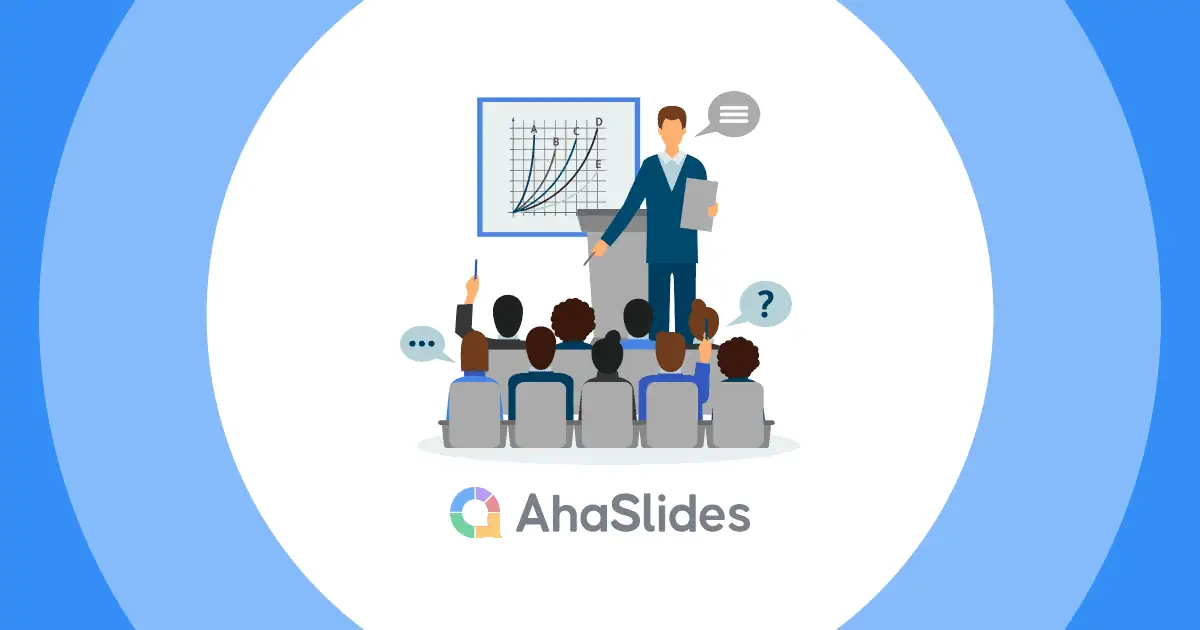Chapter 0: Is Your Training Method Stuck?
You just finished another training session. You shared your best material. But something felt off.
Half the room was scrolling on their phones. The other half was trying not to yawn.
You might be wondering:
"Is it me? Is it them? Is it the content?"
But here's the truth:
None of this is your fault. Or your learners' fault.
So what's really going on?
The world of training is changing fast.
But, the fundamentals of human learning haven't changed at all. And that's where the opportunity lies.
Want to know what you can do?
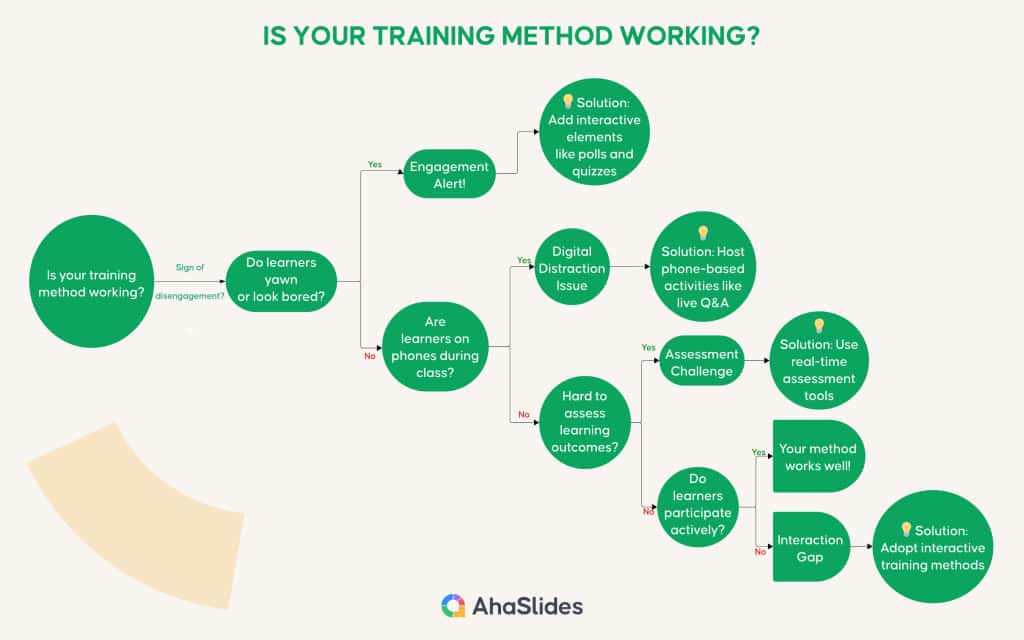
You don't need to throw out your entire training program. You don't even need to change your core content.
The solution is simpler than you think: interactive training.
That's exactly what we're about to cover in this blog post: The best ultimate guide to interactive training that will keep your learners glued to every word:
- What is Interactive Training?
- Interactive vs. Traditional Training - Why It's Time to Switch
- How to Measure Training Success (With Real Numbers)
- How to Make Interactive Training Sessions with AhaSlides
- Interactive Training Success Stories
Ready to make your training impossible to ignore?
Let's begin.
Table of Contents
- Chapter 0: Is Your Training Method Stuck?
- Chapter 1: What is Interactive Training?
- Chapter 2: Interactive vs. Traditional Training - Why It's Time to Switch
- Chapter 3: How to Actually Measure Training Success
- Chapter 4: How to Make Interactive Training Sessions with AhaSlides
- Chapter 5: Interactive Training Success Stories
- Conclusion
Chapter 1: What is Interactive Training?
What is Interactive Training?
Traditional training is boring. You know the drill - someone talks at you for hours while you fight to keep your eyes open.
Here's the thing:
Interactive training is completely different.
How?
In traditional training, learners just sit and listen. In interactive training, instead of falling asleep, your learners actually participate. They answer questions. They compete in quizzes. They share ideas in real-time.
The fact is that when people participate, they pay attention. When they pay attention, they remember.
Generally speaking, interactive training is all about getting learners involved. This modern method makes learning more fun and effective.
What I mean is:
- Live polls that everyone can answer from their phones
- Quizzes that get competitive
- Word clouds build themselves as people share ideas
- Q&A sessions where nobody's afraid to ask "dumb questions"
- ...
The best part?
It actually works. Let me show you why.
Why Your Brain Loves Interactive Training
Your brain is like a muscle. It gets stronger when you use it.
Think about this:
You probably remember the lyrics to your favourite song from high school. But what about that presentation from last week?
That's because your brain remembers things better when you're actively involved.
And researches back this up:
- People remember 70% more when they actually DO something vs. just listening (Edgar Dale’s Cone of Experience)
- Interactive learning boosts memory by 70% vs traditional methods. (Educational Technology Research and Development)
- 80% of employees believe interactive training is more engaging than traditional lectures (TalentLMS)
In other words, when you actively participate in learning, your brain goes into overdrive. You're not just hearing information - you're processing it, using it, and storing it.
3+ Significant Benefits of Interactive Training
Let me show you the 3 biggest benefits of switching to interactive training.
1. Better engagement
The interactive activities keep trainees interested and focused.
Because now they're not just listening - they're in the game. They're answering questions. They're solving problems. They're competing with their colleagues.
2. Higher retention
Trainees remember more of what they learn.
Your brain only remembers 20% of what you hear, but 90% of what you do. Interactive training puts your people in the driver's seat. They practice. They fail. They succeed. And most importantly? They remember.
3. More satisfaction
Trainees enjoy the training more when they can take part.
Yes, boring training sessions suck. But make it interactive? Everything changes. No more sleeping faces or hidden phones under the table - your team actually gets excited about the sessions.
Getting these benefits isn't rocket science. You just need the right tools with the right features.
But how can you know which is the best tool for interactive training?
5+ Key Features of Interactive Training Tools
This is crazy:
The best interactive training tools aren't complicated. They're dead simple.
So, what makes a great interactive training tool?
Here are some key features that matter:
- Real-time quizzes: Test the audience’s knowledge right away.
- Live polls: Let learners share their thoughts and opinions right from their phones.
- Word clouds: Gathers everyone's ideas in one place.
- Brainstorming: Allows learners to discuss and solve problems together.
- Q&A sessions: Learners can get their questions answered, no hand-raising needed.
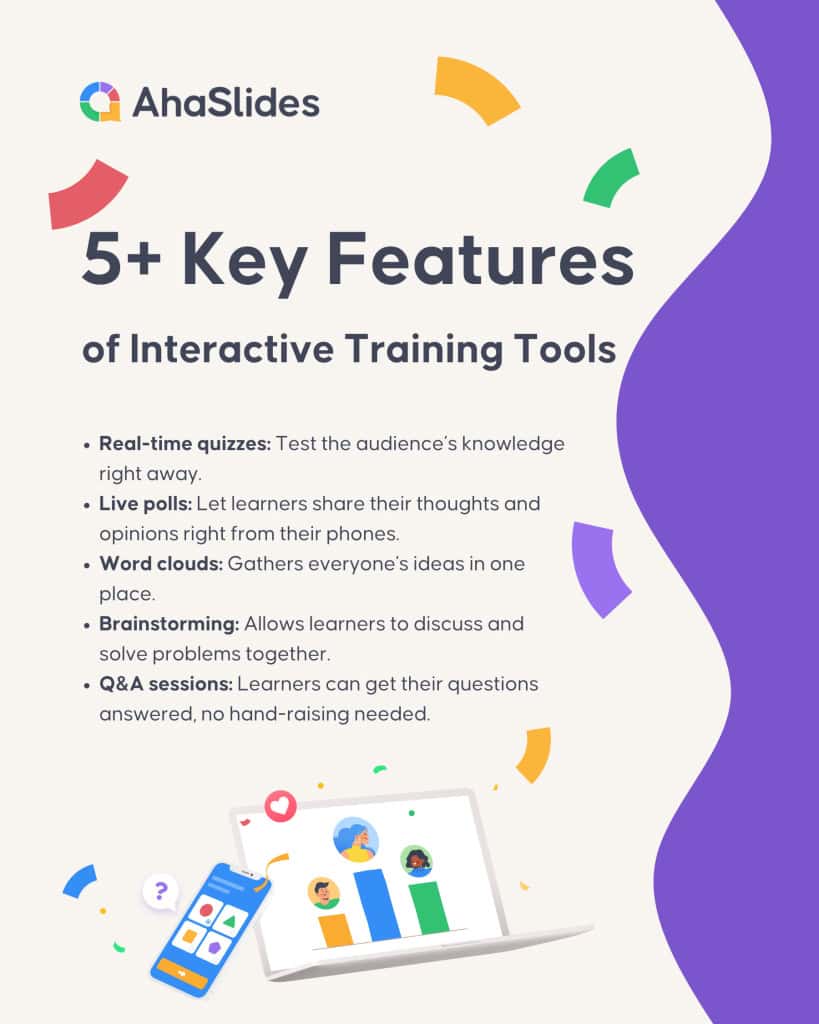
Now:
These features are great. But I hear what you're thinking: How do they actually stack up against traditional training methods?
That's exactly what's coming up next.
Chapter 2: Interactive vs. Traditional Training - Why It's Time to Switch
Interactive vs Traditional Training
Here's the truth: Traditional training is dying. And there's data to prove it.
Let me show you exactly why:
| Factors | Traditional Training | Interactive Training |
|---|---|---|
| Engagement | 😴 People zone out after 10 mins | 🔥 85% stay engaged throughout |
| Retention | 📉 5% remember after 24 hours | 📈 75% remember after a week |
| Participation | 🤚 Only loud people speak up | ✨ Everyone joins in (anonymously!) |
| Feedback | ⏰ Wait till final test | ⚡ Get instant feedback |
| Pace | 🐌 Same pace for everyone | 🏃♀️ Adapts to learner speed |
| Content | 📚 Long lectures | 🎮 Short, interactive chunks |
| Tools | 📝 Paper handouts | 📱 Digital, mobile-friendly |
| Assessment | 📋 End-of-course tests | 🎯 Real-time knowledge checks |
| Questions | 😰 Afraid to ask "dumb" questions | 💬 Anonymous Q&A anytime |
| Cost | 💰 High printing & venue costs | 💻Lower costs, better results |
How Social Media Changed Training Forever (And What to Do)
Let's face it: Your learners' brains have changed.
Why?
Here's what today's learners are used to:
- 🎬 TikTok videos: 15-60 seconds
- 📱 Instagram Reels: under 90 seconds
- 🎯 YouTube Shorts: 60 seconds max
- 💬 Twitter: 280 characters
Compare that to:
- 📚 Traditional training: 60+ minute sessions
- 🥱 PowerPoint: 30+ slides
- 😴 Lectures: Hours of talking
See the problem?
How TikTok changed how we learn...
Let's break this down:
1. Attention spans have changed
Old days:
- Could focus for 20+ minutes.
- Read long documents.
- Sat through lectures.
Now:
- 8-second attention spans.
- Scan instead of read.
- Need constant stimulation
2. Content expectations are different
Old days:
- Long lectures.
- Walls of text.
- Boring slides.
Now:
- Quick hits.
- Visual content.
- Mobile-first.
3. Interaction is the new normal
Old days:
- You talk. They listen.
Now:
- Two-way communication. Everyone's involved.
- Instant feedback.
- Social elements.
Here’s the table that tells the whole story. Take a look:
| Old Expectations | New Expectations |
|---|---|
| Sit and listen | Interact and engage |
| Wait for feedback | Instant responses |
| Follow the schedule | Learn at their pace |
| One-way lectures | Two-way conversations |
| Same content for all | Personalised learning |
How to Make Your Training Work Today (5 Ideas)
What I want to express is: You're doing more than just teaching. You're competing with TikTok and Instagram - apps designed to be addictive. But here's the good news: You don't need tricks. You just need a smart design. Here are 5 powerful interactive training ideas you should try at least once (trust me on these):
Use quick polls
Let me be clear: Nothing kills a session faster than one-way lectures. But throw in a quick poll? Watch what happens. Every phone in the room will focus on YOUR content. For example, you can drop a poll every 10 minutes. Trust me - it works. You'll get instant feedback on what's landing and what needs work.
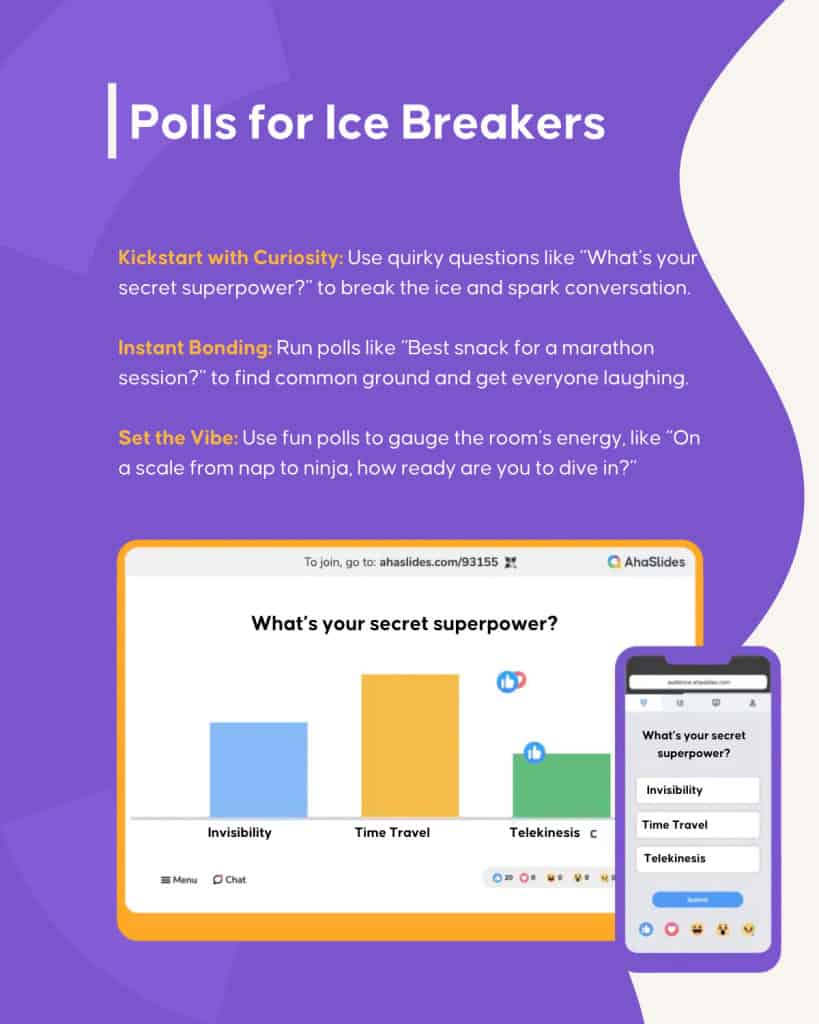
Gamify with interactive quizzes
Regular quizzes put people to sleep. But interactive quizzes with leaderboards? They can light up the room. Your participants don't just answer – they compete. They get hooked. And when people are hooked, learning sticks.

Transform questions into conversations
The fact is that 90% of your audience has questions, but most won't raise their hands. Solution? Open a live Q&A session and make it anonymous. BOOM. Watch questions flood in like Instagram comments. Those quiet participants who never speak up will become your most engaged contributors.

Visualise group thinking
Want to 10x your brainstorming sessions? Launch a word cloud. Let everyone throw in ideas simultaneously. A word cloud will turn random thoughts into a visual masterpiece of collective thinking. And unlike traditional brainstorming where the loudest voice wins, everyone gets equal input.

Add random fun with a spinner wheel
Dead silence is every trainer's nightmare. But here's a trick that works every time: Spinner wheel.
Use this when you see attention dropping. One spin and everyone's back in the game.
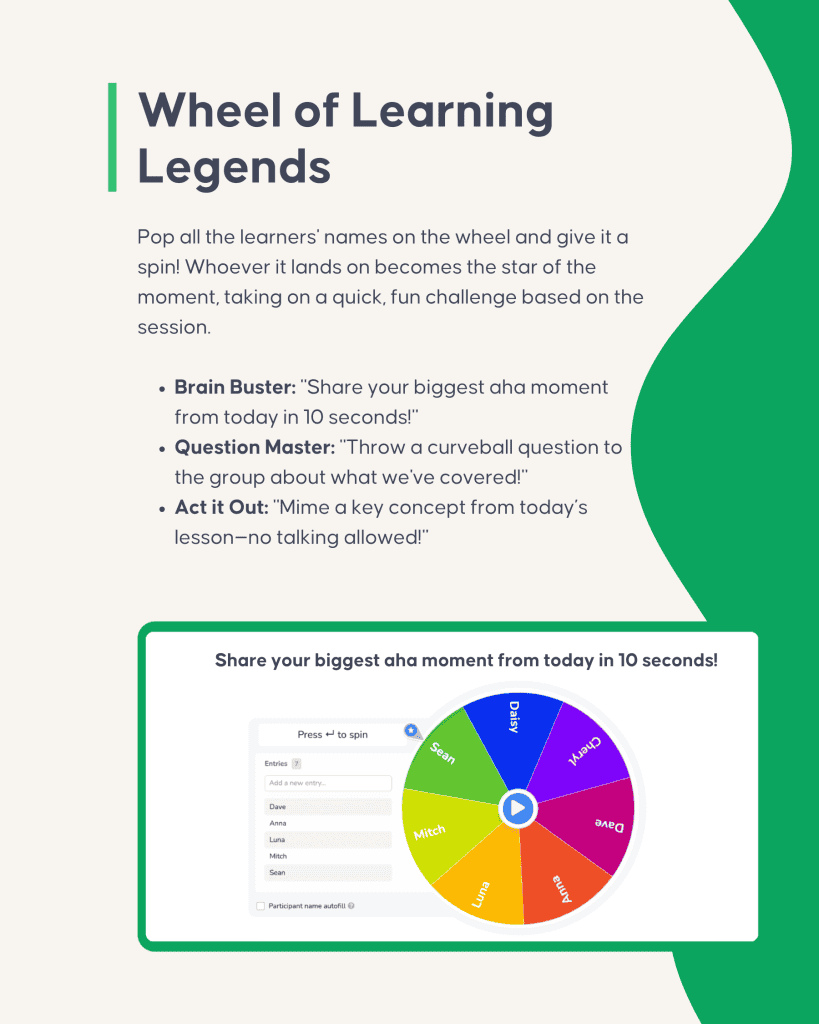
Now that you know how to upgrade your training, there's just one question left:
How do you know it's actually working?
Let's look at the numbers.
Chapter 3: How to Actually Measure Training Success (with Real Numbers)
Forget vanity metrics. Here's what really shows if your training works:
The Only 5 Metrics That Matter
First, let's be clear:
Just counting heads in the room doesn't cut it anymore. Here's what really matters to track if your training is working:
1. Engagement
This is the big one.
Think about it: If people are engaged, they're learning. If they're not, they're probably on TikTok.
Track these:
- How many people answer polls/quizzes (aim for 80%+)
- Who's asking questions (more = better)
- Who's joining activities (should increase over time)
2. Knowledge checks
Simple but powerful.
Run quick quizzes:
- Before training (what they know)
- During training (what they're learning)
- After training (what stuck)
The difference tells you if it's working.
3. Completion rates
Yes, basic. But important.
Good training sees:
- 85%+ completion rates
- Less than 10% dropouts
- Most people finish early
4. Understanding levels
You can't always see results tomorrow. But you can see if people "get it" by using anonymous Q&As. They're goldmines for finding what people REALLY understand (or don't).
And then, track these:
- Open-ended responses that show real comprehension
- Follow-up questions that reveal a deeper understanding
- Group discussions where people build on each other's ideas
5. Satisfaction scores
Happy learners = Better results.
You should aim for:
- 8+ out of 10 satisfaction
- "Would recommend" responses
- Positive comments
How AhaSlides Makes This Easy
While other training tools just help you make slides, AhaSlides can also show you exactly what's working. One tool. Double the impact.
How? Here is the way AhaSlides tracks your training success:
| What you need | How AhaSlides helps |
|---|---|
| 🎯 Create interactive training | ✅ Live polls & quizzes ✅ Word clouds & brainstorms ✅ Team competitions ✅ Q&A sessions ✅ Real-time feedback |
| 📈 Real-time tracking | Get numbers on: ✅ Who joined in ✅ What they answered ✅ Where they struggled |
| 💬 Easy feedback | Collect responses through: ✅ Quick polls ✅ Anonymous questions ✅ Live reactions |
| 🔍 Smart analytics | Track everything automatically: ✅ Total participants ✅ Quiz scores ✅ Avg. submissions ✅ Rating |
So AhaSlides tracks your success. Great.
But first, you need interactive training worth measuring.
Want to see how to create it?
Chapter 4: How to Make Interactive Training Sessions with AhaSlides (Step-by-Step Guide)
Enough theory. Let's get practical.
Let me show you exactly how to make your training more engaging with AhaSlides (your must-have interactive training platform).
Step 1: Get set up
Here's what to do:
- Head to AhaSlides.com
- Click "Sign up free"
- Create your first presentation
That's it, really.
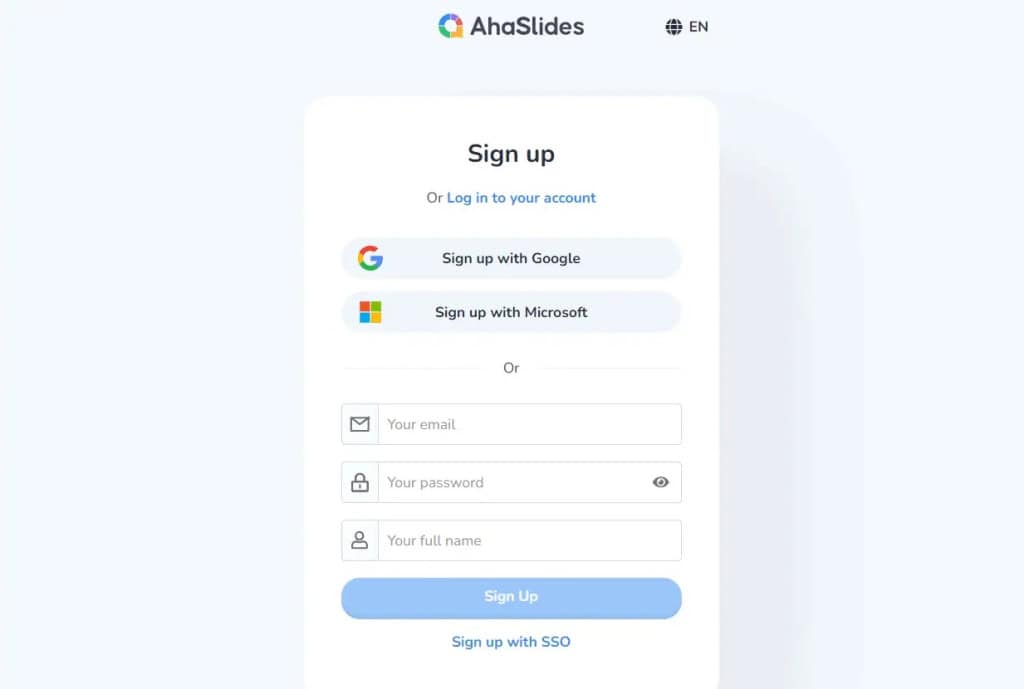
Step 2: Add interactive elements
Just click "+" and choose any of these:
- Quizzes: Make learning fun with automatic scoring and leaderboards
- Polls: Gather opinions and insights instantly
- Word Cloud: Generate ideas together with word clouds
- Live Q&A: Encourage questions and open dialogue
- Spinner Wheel: Add surprise elements to gamify sessions
Step 3: Use your old stuff?
You have old content? No problem.
PowerPoint Import
Got PowerPoint? Perfect.
Here's what to do:
- Click "Import PowerPoint"
- Drop your file in
- Add interactive slides between yours
Done.
Better yet? You can use AhaSlides directly in PowerPoint with our add-in!
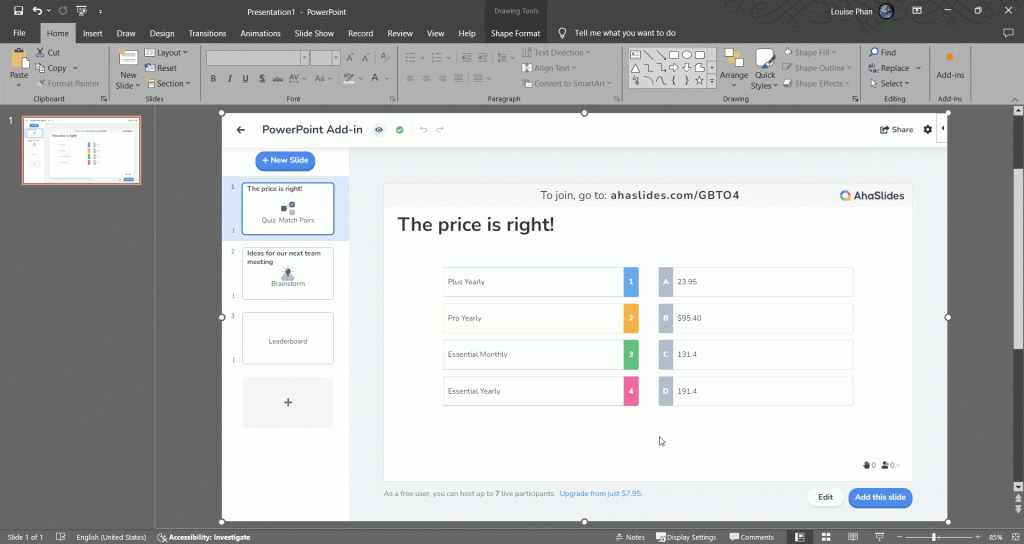
Platform Add-ins
Using Microsoft Teams or Zoom for meetings? AhaSlides works right inside them with add-ins! No jumping between apps. No hassle.
Step 4: Show-time
Now you’re ready to present.
- Hit "Present"
- Share the QR code
- Watch people join
Super simple.
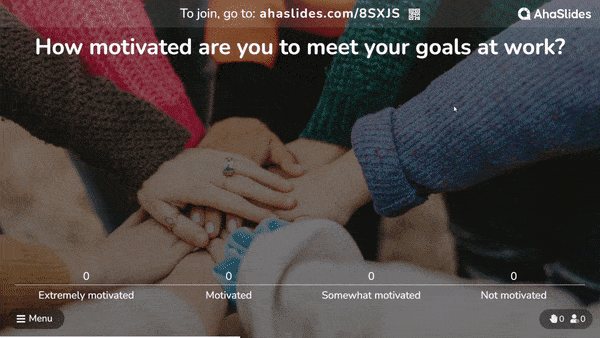
Let me make this super clear:
Here's exactly how your audience will interact with your slides (You'll love how simple this is). 👇
(You'll love how simple this is)
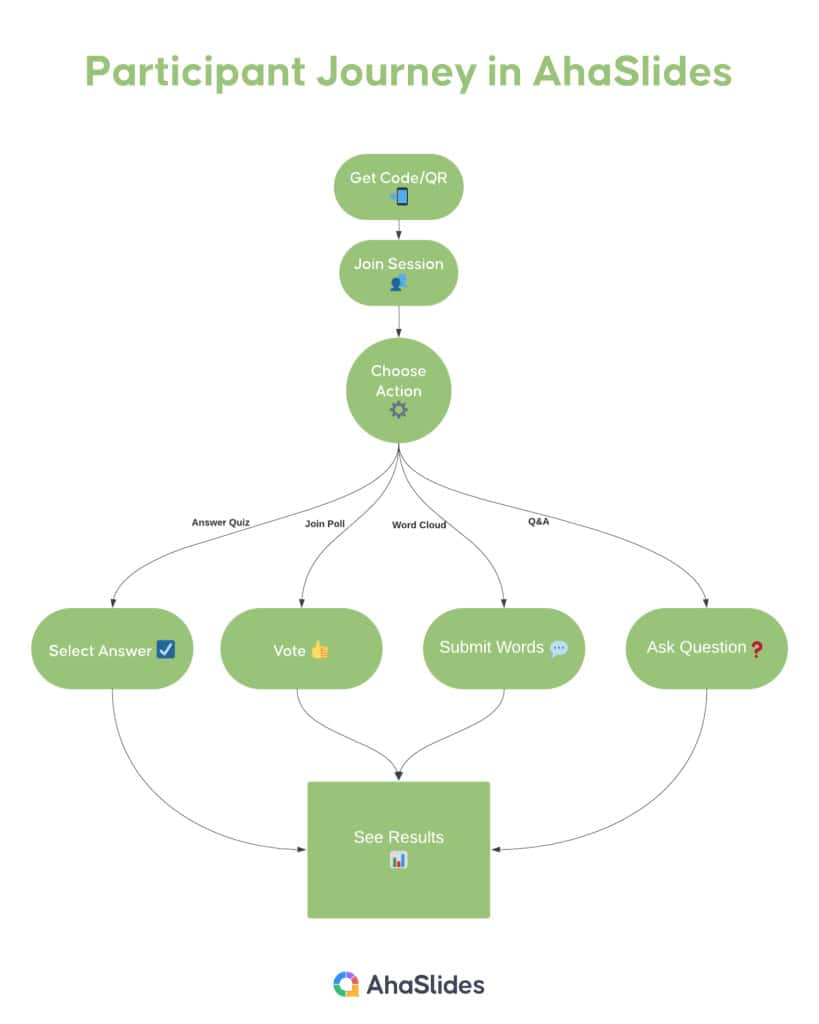
Chapter 5: Interactive Training Success Stories (That Actually Worked)
Big companies are already seeing massive wins with interactive training. There are some successful stories that might make you wow:
AstraZeneca
One of the best interactive training examples is AstraZeneca's story. International pharmaceutical giant AstraZeneca needed to train 500 sales agents on a new drug. So, they turned their sales training into a voluntary game. No forcing. No requirements. Just team competitions, rewards, and leaderboards. And the result? 97% of agents joined in. 95% finished every session. And get this: most played outside work hours. One game did three things: built teams, taught skills, and fired up the sales force.
Deloitte
In 2008, Deloitte established the Deloitte Leadership Academy (DLA) as an online internal training program, and they made a simple change. Instead of just training, Deloitte used gamification principles to boost engagement and regular participation. Employees can share their achievements on LinkedIn, boosting the public reputation of individual employees. Learning became career-building. The result was clear: engagement rose 37%. So effective, they built Deloitte University to bring this approach into the real world.
The National Technical University of Athens
The National Technical University of Athens ran an experiment with 365 students. Traditional lectures vs interactive learning.
The difference?
- Interactive methods improved performance by 89.45%
- Overall student performance jumped 34.75%
Their findings show that when you turn statistics into a series of challenges with interactive activities, learning improves naturally.
Those are the big companies and universities. But what about everyday trainers?
Here are some trainers who have shifted to interactive methods using AhaSlides and their results…
Trainer testimonials

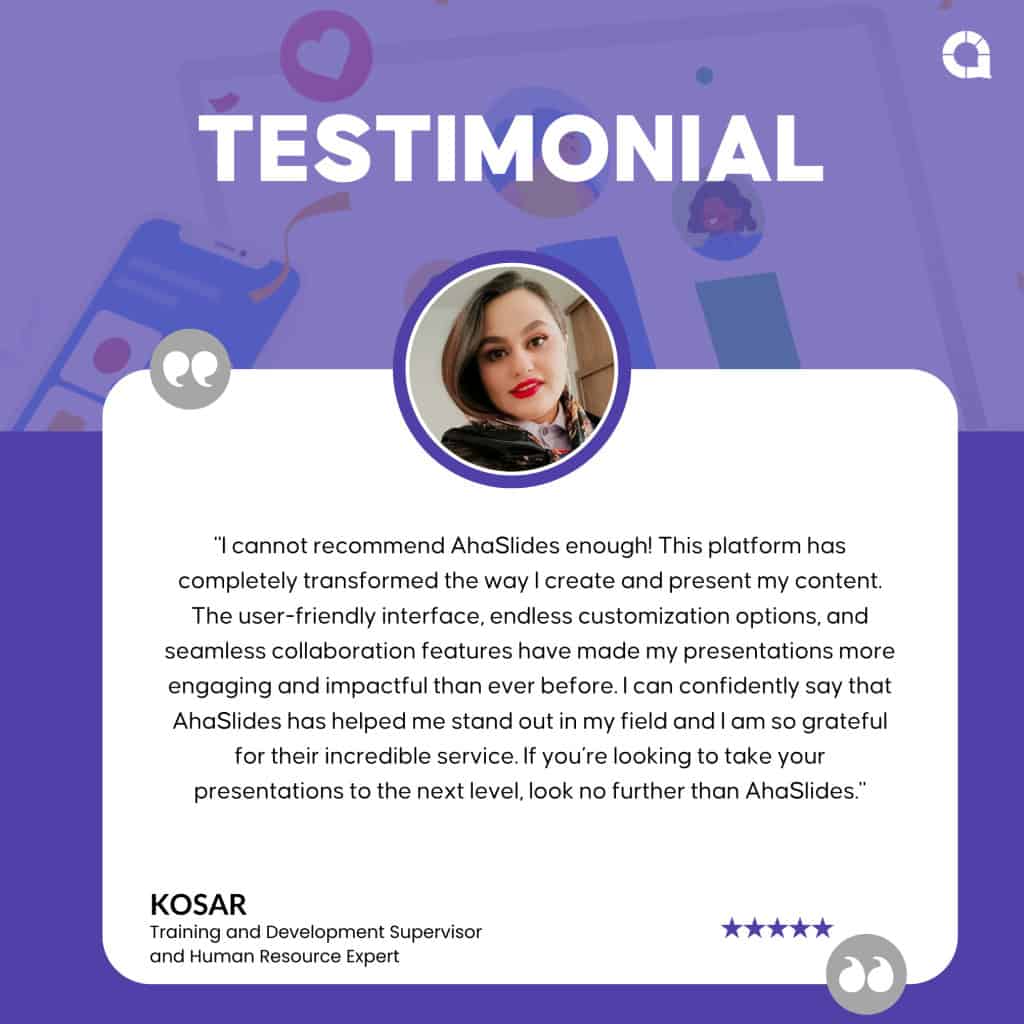
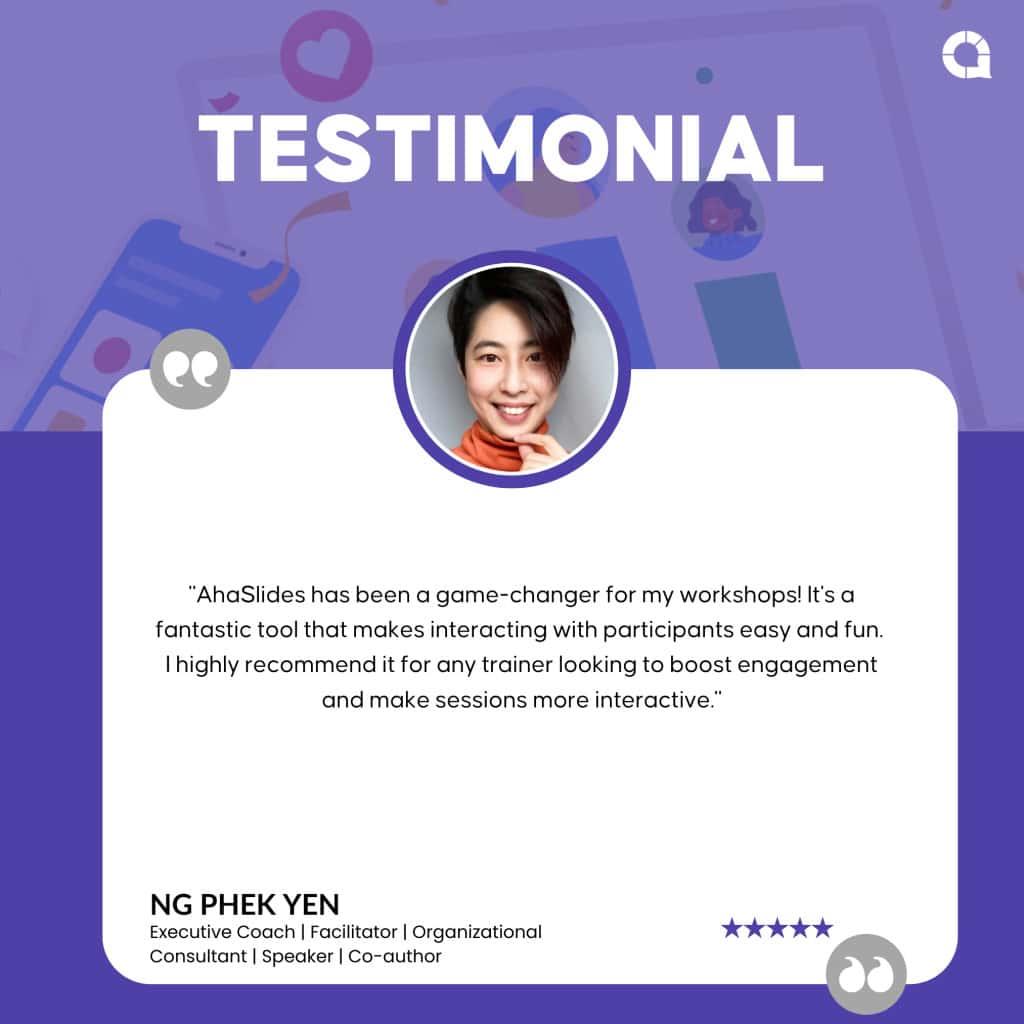
Conclusion
So, that’s my guide to interactive training.
Before we say goodbye, let me be clear about something:
Interactive training works. Not because it's new. Not because it's trendy. It works because it matches how we naturally learn.
And your next move?
You don't need to buy expensive training tools, rebuild all your training or become an entertainment expert. Really, you don't.
Don't overthink this.
You just need to:
- Add one interactive element to your next session
- Watch what works
- Do more of that
That's all you need to focus on.
Make interactivity your default, not your exception. The results will speak for themselves.

